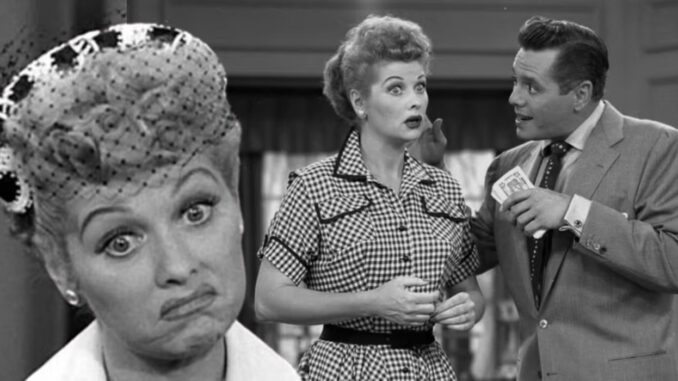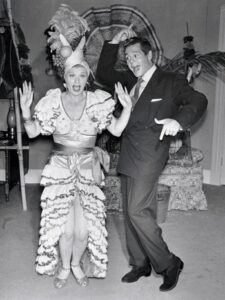
Introduction: The Legacy of ‘I Love Lucy’
Have you ever wondered how a TV show from the 1950s managed to stay iconic even in today’s fast-paced, ever-changing entertainment world? The answer lies in one name: ‘I Love Lucy.’ From its debut in 1951, the sitcom not only captivated audiences but also set records that were virtually untouchable at the time. Let’s explore the secrets behind this ratings juggernaut that turned Lucy, Ricky, Fred, and Ethel into household names.
The Revolutionary Concept That Hooked Viewers
A Real Couple, a Real Connection
At its core, the show’s charm came from its leads—Lucille Ball and Desi Arnaz—who were a real-life married couple. Viewers felt like they were getting a sneak peek into a genuine relationship, making it relatable and heartwarming.
The Blend of Comedy and Heart
‘I Love Lucy’ wasn’t just about slapstick humor; it was about love, misunderstandings, and reconciliation. This mix of emotional depth and laugh-out-loud moments made it stand out among the competition.

Television Innovation That Changed the Game
The Three-Camera Technique
Before ‘I Love Lucy,’ sitcoms were typically filmed like stage plays. But Desi Arnaz and director Karl Freund revolutionized the industry with the three-camera system, allowing for better angles, smoother editing, and a live studio audience.
First-Ever Syndication Deal
Desi and Lucille’s decision to produce the show themselves allowed them to retain ownership. This bold move paved the way for syndication, meaning ‘I Love Lucy’ could continue airing long after its original run, earning millions of new fans.
The Power of Timing: Capturing the Post-War Audience
A Nation Ready to Laugh
The early 1950s were a time of transition. After the hardships of World War II, Americans were ready for humor and joy. ‘I Love Lucy’ offered the perfect escape.
Appealing to the Average Family
With Lucy and Ricky living in a modest New York apartment, viewers saw their lives mirrored on screen. The show wasn’t about the rich or glamorous but about ordinary folks—just like them.
Breaking Records, One Episode at a Time
The Birth of Appointment TV
When Lucy went into labor on-screen in the episode “Lucy Goes to the Hospital,” over 44 million viewers tuned in—more than the audience for President Eisenhower’s inauguration. This proved the power of serialized storytelling on television.
Consistent Top Ratings
For four of its six seasons, ‘I Love Lucy’ was the most-watched show in America. In fact, during its second season, it was estimated that more than two-thirds of all TVs in use were tuned to Lucy.
Unforgettable Characters That Won Hearts
Lucille Ball’s Comedy Genius
Lucy Ricardo’s mix of ambition, mischief, and comedic timing made her a once-in-a-generation character. Her physical comedy—whether stomping grapes or stuffing chocolates—still brings laughter decades later.
Desi Arnaz as Ricky Ricardo
Desi wasn’t just a straight man to Lucy’s antics; his charm, musical talent, and iconic “Babalu” performances added an extra layer to the show.
Fred and Ethel: The Ultimate Sidekicks
William Frawley and Vivian Vance brought depth and humor to the Ricardos’ best friends, creating a dynamic that perfectly complemented the main couple.
Why ‘I Love Lucy’ Still Matters Today
Setting the Sitcom Standard
Almost every sitcom that came after owes something to ‘I Love Lucy.’ From the use of ensemble casts to situational humor, it set the gold standard.
Timeless Humor
While trends come and go, laughter remains universal. The humor in ‘I Love Lucy’ transcends decades, proving that good comedy never goes out of style.
Cultural Impact: Beyond TV Ratings
Merchandising and Fandom
‘I Love Lucy’ wasn’t just a show; it was a phenomenon. From lunchboxes to dolls, it was one of the first TV shows to capitalize on its popularity with merchandise.
Global Reach
The show has been translated into dozens of languages and aired in countries around the world, proving that its appeal isn’t confined to American audiences.
Lessons From the Success of ‘I Love Lucy’
Authenticity Wins Hearts
Lucille Ball and Desi Arnaz’s genuine chemistry proved that authenticity resonates deeply with viewers.
Innovation Pays Off
By taking risks—whether in production techniques or storytelling—the team behind ‘I Love Lucy’ proved that bold ideas can lead to groundbreaking success.
Conclusion: The Enduring Legacy of ‘I Love Lucy’
‘I Love Lucy’ wasn’t just a TV show; it was a revolution. It changed how television was produced, consumed, and remembered. Even decades later, its episodes continue to draw laughs and admiration, proving that Lucy and her gang were, and always will be, TV royalty.
FAQs
1. Why was ‘I Love Lucy’ so popular during its time?
The show resonated with audiences due to its relatable characters, genuine humor, and innovative production techniques like the three-camera setup.
2. How many seasons did ‘I Love Lucy’ run?
The show aired for six seasons from 1951 to 1957, with 181 episodes.
3. What made Lucille Ball a comedy icon?
Lucille Ball’s impeccable timing, fearless physical comedy, and ability to connect emotionally with the audience solidified her status as a legend.
4. Why is ‘I Love Lucy’ still considered a classic today?
Its universal humor, groundbreaking innovations, and lovable characters ensure its relevance and popularity across generations.
5. What was the most-watched episode of ‘I Love Lucy’?
“Lucy Goes to the Hospital,” where Lucy gives birth to Little Ricky, attracted over 44 million viewers, making it a landmark moment in TV history.
